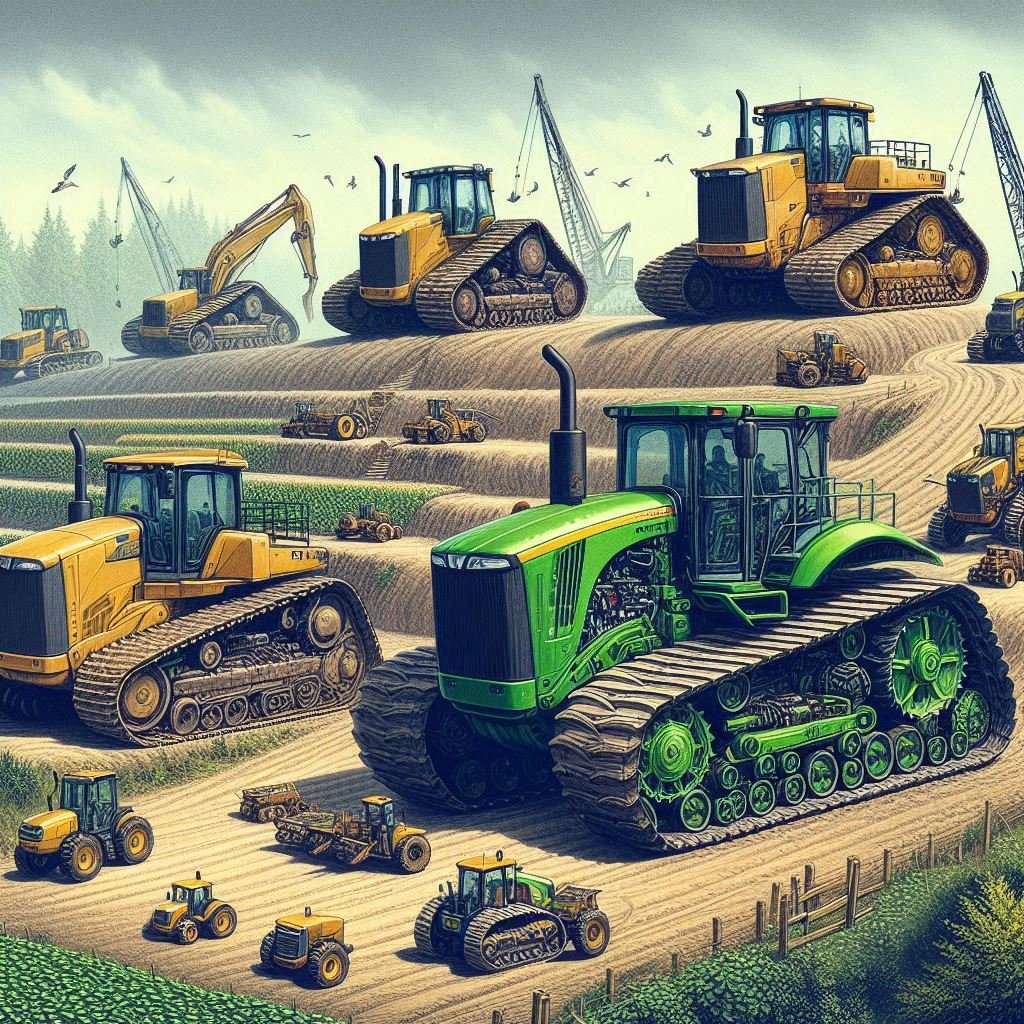Crawler tractors, also known as tracked tractors or track-laying tractors, have evolved significantly over the past century. Originally designed to improve agricultural efficiency, these powerful machines have since become essential equipment on construction sites, in forestry, and even in military applications. This article explores the history, technological advancements, and diverse applications of crawler tractors, highlighting how these versatile machines have evolved from farm fields to multi-purpose machines across various industries.

1. The Early Days of Crawler Tractors: Innovation on the Farm
The concept of crawler tractors dates back to the late 19th century, a time when mechanized farming was beginning to take shape. Early farming relied heavily on horses, oxen, and human labor, but as farmers sought more efficient ways to work large areas of land, they turned to steam-powered and later gasoline-powered machinery. Traditional wheeled tractors, however, struggled on soft, uneven farmland where tires could easily get stuck.
The Birth of the Track System
The solution to this problem was the development of the continuous track, or “crawler” system, designed to improve traction on soft ground. One of the earliest experiments with tracked vehicles came from British engineer David Roberts in the 1880s, who fitted a steam traction engine with continuous tracks. Around the same time, in the United States, Benjamin Holt of the Holt Manufacturing Company (later Caterpillar Inc.) and Daniel Best were experimenting with tractor designs for agriculture. In 1904, Holt created one of the first successful crawler tractors, which he called the “Caterpillar.” The crawler tractor’s design used a continuous steel track instead of wheels, significantly improving traction and weight distribution over soft ground.
Holt’s “Caterpillar” crawler tractor revolutionized farming by enabling work on challenging soil types. It reduced soil compaction, improved efficiency, and allowed farmers to cultivate more land with less effort. The design proved to be such a game-changer that by the 1920s, crawler tractors were in high demand for agricultural work, especially in regions with muddy, sandy, or uneven soil conditions.
2. Transition to Construction: A Machine for Tough Terrain
While crawler tractors gained popularity on farms, their potential soon caught the attention of the construction industry. As infrastructure projects expanded, particularly in the United States and Europe, contractors needed equipment capable of operating on rough, muddy, or steep terrains that traditional wheeled vehicles couldn’t handle. The crawler tractor’s stability and maneuverability made it ideal for moving earth, leveling ground, and performing tasks on rugged construction sites.
World War I: Military Demand and Technological Advancements
The crawler tractor saw its first significant use beyond agriculture during World War I. Armies needed vehicles that could navigate rough, muddy, and bomb-cratered battlefields, and the crawler tractor’s design made it a natural fit. Holt’s Caterpillar tractors were repurposed to tow artillery and equipment, and many were used by the Allies in Europe. This wartime application demonstrated the machine’s versatility, prompting further innovation in the post-war years.
Following the war, the construction industry saw an increase in infrastructure projects, particularly for roads, bridges, and dams. The crawler tractor’s design was adapted to fit the demands of heavy construction, and companies like Caterpillar began to develop specialized equipment for these projects. Bulldozers—crawler tractors equipped with a blade for pushing earth—emerged as one of the most common applications of crawler tractors on construction sites, revolutionizing how earthmoving and grading tasks were performed.
3. Technological Advancements: From Steam to Diesel and Beyond
As the demand for crawler tractors grew, so did the need for more efficient and powerful engines. The early steam-powered models were heavy and cumbersome, and by the 1920s, gasoline-powered crawler tractors were becoming more common. However, gasoline engines were not ideal for heavy-duty tasks due to fuel consumption and maintenance issues. The solution came in the form of diesel engines.
The Rise of Diesel Engines
In the 1930s, manufacturers began equipping crawler tractors with diesel engines, which offered several advantages over gasoline engines. Diesel engines were more fuel-efficient, had better torque for heavy-duty work, and were more durable under challenging conditions. Caterpillar, among others, played a significant role in this transition, and diesel-powered crawler tractors soon became the industry standard for construction and agricultural equipment.
Hydraulics and Power Take-Off (PTO) Systems
By the 1940s, crawler tractors were also being fitted with hydraulic systems, enabling them to perform a broader range of tasks. Hydraulics allowed operators to control attachments like bulldozer blades, loaders, and rippers with greater precision and ease. The addition of a Power Take-Off (PTO) system further enhanced functionality by allowing the tractor’s engine to power other equipment, such as rotary tillers and posthole diggers. These advancements made crawler tractors versatile tools that could tackle various construction and agricultural tasks beyond simple transportation and towing.
4. Expansion into New Industries: Forestry, Mining, and Military Applications
The versatility of crawler tractors and the continuous improvements in their design allowed them to be adapted for use in various industries beyond agriculture and construction.
Forestry and Logging
In forestry, crawler tractors became essential for logging operations. Their ability to maneuver on steep, rugged terrain made them ideal for transporting heavy logs and operating in dense forests. Attachments such as winches and grapples were added to crawler tractors, enabling them to haul logs out of forests with ease. Some models were even modified to operate on snow and in remote wilderness areas, broadening their usability in forestry work.
Mining
The mining industry also benefited from crawler tractors. Mines often required machines that could move large quantities of earth and handle heavy equipment, even in narrow, confined spaces. Crawler tractors with specialized attachments were introduced to perform tasks such as stripping topsoil, building access roads, and carrying equipment. In surface mining, crawler tractors became indispensable for clearing overburden and transporting materials.
Military Applications
Following World War I, the military continued to use crawler tractors for various purposes, including as engineering vehicles, tank recovery, and logistical support. The U.S. military, for instance, employed armored versions of crawler tractors in World War II, using them to build runways, clear obstacles, and transport heavy artillery across rugged terrain. Crawler tractors played a vital role in combat engineering, helping soldiers construct fortifications and infrastructure in challenging environments.
5. Modern Innovations in Crawler Tractors
As technology advanced, so did crawler tractors, incorporating digital controls, automated systems, and environmentally friendly engines.
GPS and Precision Control
Today, many crawler tractors come equipped with GPS and precision control systems. In agriculture, GPS technology allows for highly accurate tilling, planting, and harvesting, minimizing overlaps and reducing waste. In construction, precision control systems enable operators to perform grading and excavation tasks with incredible accuracy, which helps save time, reduce fuel consumption, and minimize the need for rework.
Automation and Remote Operation
With the rise of automation, some crawler tractors can now be operated remotely or even autonomously. Remote operation allows operators to control machines from a safe distance, which is especially valuable in hazardous environments like mining or demolition sites. Autonomous crawler tractors, though still in early stages, have the potential to increase productivity by allowing machines to work around the clock with minimal human supervision.
Hybrid and Electric Models
As environmental concerns grow, manufacturers are also exploring hybrid and electric crawler tractors to reduce fuel consumption and emissions. Hybrid models use a combination of diesel and electric power, which can improve fuel efficiency and lower operating costs. Fully electric crawler tractors are still in development but represent a promising future for industries aiming to reduce their environmental footprint.
6. Crawler Tractors in the Future: Trends and Prospects
The future of crawler tractors looks promising, with continued innovations aimed at increasing efficiency, safety, and sustainability.
- Sustainable Materials and Energy Sources: Manufacturers are likely to explore eco-friendly materials and cleaner energy sources, including biofuels and renewable power systems.
- Enhanced Safety Features: Improved safety technology, including obstacle detection, collision prevention, and automated shutdown systems, will likely become standard in the coming years.
- Integration with Smart Infrastructure: The rise of smart infrastructure and connected construction sites could enable crawler tractors to communicate with other equipment, optimize work sequences, and improve overall project efficiency.
Conclusion
From its humble beginnings on muddy farms to its indispensable role in modern construction, forestry, mining, and military applications, the crawler tractor has come a long way. Over the years, it has been refined and adapted to meet the needs of various industries, becoming one of the most versatile machines in heavy equipment. Today’s crawler tractors are equipped with advanced technology, enabling them to operate with greater precision, power, and efficiency.
The evolution of crawler tractors highlights not only advances in engineering and machinery but also the adaptability of these machines to new challenges and environments. As industries continue to evolve, crawler tractors will remain at the forefront, pushing boundaries in infrastructure development, agriculture, and beyond.





Very good!
Giod
Thanks
Nice
The place is very beautiful and wonderful
ممتاز جداً
Xfnzuxiaksjxud9ek djxiexirjxrjxurj